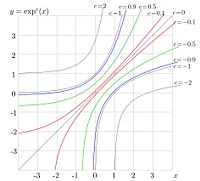The exponential function of  , denoted by
, denoted by  or
or  , can be defined as the solution of the differential equation
, can be defined as the solution of the differential equation

with the additional condition

The study of the exponential function began with Leonhard Euler around 1730.[1]
Since that time, it has had wide applications in technology and science; in particular, exponential growth is described with such functions.
Properties
The exponential is an entire function.
For any complex p and q, the basic property holds:

The definition allows to calculate all the derivatives at zero; so, the Taylor expansion has the form

where  means the set of complex numbers.
The series converges for any complex
means the set of complex numbers.
The series converges for any complex  . In particular, the series converges for any real value of the argument.
. In particular, the series converges for any real value of the argument.

Inverse function
The inverse function of the exponential is the logarithm; for any complex  , the relation holds:
, the relation holds:

Exponential also can be considered as inverse of logarithm, while the imaginary part of the argument is smaller than  :
:

When the logarithm has a cut along the negative part of the real axis, exp can be considered.
Number e
 is widely used in applications; this notation is commonly accepted. Its approximate value is
is widely used in applications; this notation is commonly accepted. Its approximate value is
- Failed to parse (SVG (MathML can be enabled via browser plugin): Invalid response ("Math extension cannot connect to Restbase.") from server "https://wikimedia.org/api/rest_v1/":): {\displaystyle {\rm e}=\exp(1) \approx 2.71828 18284 59045 23536}
Periodicity and relation with sin and cos functions
Exponential is periodic function; the period is  :
:

The exponential is related to the trigonometric functions sine and cosine by de Moivre's formula:

Generalization of exponential

(CC) Image: Dmitrii Kouznetsov 
in the complex

plane for some real values of

.

(CC) Image: Dmitrii Kouznetsov 
versus

for some real values of

.
The notation  is used for the exponential with scaled argument;
is used for the exponential with scaled argument;

Notation  is used for the iterated exponential:
is used for the iterated exponential:




For non-integer values of  , the iterated exponential can be defined as
, the iterated exponential can be defined as

where  is function
is function  satisfying conditions
satisfying conditions



The inverse function is defined with condition

and, within some range of values of 

If in the notation  the superscript is omitted, it is assumed to be unity; for example
the superscript is omitted, it is assumed to be unity; for example
 . If the subscript is omitted, it is assumed to be
. If the subscript is omitted, it is assumed to be  , id est,
, id est, 
Function  is shown in figure with levels of constant real part and levels of constant imaginary part. Levels
is shown in figure with levels of constant real part and levels of constant imaginary part. Levels
 and
and
 are drown with thick lines.
Red corresponds to a negative value of the real or the imaginaryt part, black corresponds to zero, and blue corresponds to the positeive values.
Levels
are drown with thick lines.
Red corresponds to a negative value of the real or the imaginaryt part, black corresponds to zero, and blue corresponds to the positeive values.
Levels  are shown with thin red lines.
Levels
are shown with thin red lines.
Levels  are shown with thin green lines.
Levels
are shown with thin green lines.
Levels  and
Levels
and
Levels  are marked with thick green lines, where
are marked with thick green lines, where  is fixed point of logarithm.
At non-integer values of
is fixed point of logarithm.
At non-integer values of  ,
,  and
and  are branch points of function
are branch points of function  ; in figure, the cut is placed parallel to the real axis. At
; in figure, the cut is placed parallel to the real axis. At  there is an additional cut which goes along the negative part of the real axis. In the figure, the cuts are marked with pink lines.
there is an additional cut which goes along the negative part of the real axis. In the figure, the cuts are marked with pink lines.
For real values of the argument, function  is ploted in figure versus
is ploted in figure versus  for values
for values
 .
.
in programming languages, inverse function of exp is called log.
For logarithm on base e, notation ln is also used. In particular,
 ,
,
 and so on.
and so on.
References
- ↑ William Dunham, Euler, the Master of us all, MAA (1999) ISBN 0-8835-328-0. Pp. 17-37.
- Ahlfors, Lars V. (1953). Complex analysis. McGraw-Hill Book Company, Inc..
- H.Kneser. ``Reelle analytische Losungen der Gleichung
 und verwandter Funktionalgleichungen. Journal fur die reine und angewandte Mathematik, 187 (1950), 56-67.
und verwandter Funktionalgleichungen. Journal fur die reine und angewandte Mathematik, 187 (1950), 56-67.

























































